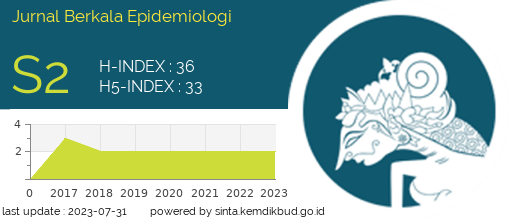ANALYSIS OF THE USE OF ANTIBIOTICS IN ASYMPTOMATIC, MILD, AND MODERATE COVID-19 PATIENTS TREATED IN BHAYANGKARA HOSPITAL
Downloads
Background: COVID-19 is an infectious disease caused by a new type of virus named SARS-CoV-2. There is still no specific treatment for COVID-19; the antibiotic is used for therapy and to prevent severe disease, so the increasing use of antibiotics in COVID-19 patients will lead to a detrimental impact and the risk of antibiotic resistance. Purpose: This study aims to analyze antibiotic use frequency and determine the number of DDD per 100 bed-days in July – December 2020 at Bhayangkara Hospital Surabaya. Methods: This research was a descriptive study with a retrospective study design conducted at Bhayangkara Hospital Surabaya in May – June 2021. The data were collected from 94 medical records, inclusion criteria: all ages; asymptomatic, mild, and moderate categories; all hospitalized patients in July-December 2020 who received antibiotics; the exclusion criteria: non-confirmed COVID-19 patients who had comorbidities and received antibiotics; the patient who died. The variables: frequency of antibiotic use with calculating the number of DDD/100 bed-days and percentage of COVID-19 patients who received antibiotics during hospitalization. Results: The frequency of antibiotic use in asymptomatic, mild, and moderate COVID-19 patients: 86.56 DDD/100 bed-days, the most antibiotic use was azithromycin at 50.42 DDD/100 bed-days and Levofloxacin at 22.70 DDD/100 bed-days. All asymptomatic, mild, and moderate COVID-19 patients (100%) at Bhayangkara Hospital Surabaya were treated with antibiotics, whereas the condition of patients was 5.32% asymptomatic, 48.94% mild, and 45.74% moderate. Conclusion: There is overuse of antibiotics in asymptomatic, mild and moderate COVID-19 patients at Bhayangkara Hospital Surabaya.
Alfhad, H., Saftarina, F. and Kurniawan, B. (2020) ‘Dampak Infeksi SARS-CoV-2 Terhadap Penderita Hipertensi', Majority, 9(1), p 1-5.
Asmarawati, T. P. et al. (2021) ‘The Clinical Impact of Bacterial Co- Infection Among Moderate, Severe and Crically Ill COVID-19 Patients in the Second Referral Hospital in Surabaya (Version 2; Peer Review: 2 Approved)', F1000 Research, p 1-16. Doi : doi.org/10.12688/f1000research.31645.2.
Audina, B., Fatekurohman, M. (2020) ‘Analisis Survival Pada Data Pasien COVID-19 di Kabupaten Jember', Berkala Sainstek, 8(4), p 118-121.
Burhan, E. et al. (2020) Pedoman Tatalaksana COVID-19. Edisi 3. Indonesia: PDPI, PERKI, PAPDI, PERDATIN, IDAI.
Colyn, E., Herawati F., and Yulia R. (2020) ‘Studi Literatur tentang Kuantitatif Penggunaan Antibiotik Pada Bangsal Bedah dengan DDD', Jurnal Kesehatan dan Kedokteran, 2(1), p 9-22. Doi : https:/doi.org/10.24123/kiesdok.v2i1.2975.
Elviani, R., Anwar C., Sitorus R. J. (2021) ‘Gambaran Usia Pada Kejadian COVID-19', JMJ, 9(2), p 204-209.
Fuadi, T. M., and Irdalisa (2020) ‘COVID-19 : Antara Angka Kematian dan Angka Kelahiran', Jurnal Sosiologi Agama Indonesia, 1(3), p 199-211. Doi : doi.org/10.22373/jsai.1i3.767.
Grace, C. (2020) ‘Manifestasi Klinis dan Perjalanan Penyakit pada Pasien COVID-19', Majority, 9(1), p 49-55.
Gunawan A. et al. (2020) ‘Pengaruh Komorbid Hipertensi Terhadap Severitas Pasien Coronavirus Disease 2019', Jurnal Implementa Husada, 1(2), p 136-151.
Gyselinck, I. et al. (2020) ‘Rationale For Azithromycin in COVID-19 : an Overview Of Existing Evidence', BMJ Open Respiratory Research, p 1-10. Doi : 10.1136/bmjresp-2020-000806.
Harahap, R. J. T. (2020) ‘Karakteristik Klinis Penyakit Coronavirus 2019', Jurnal Penelitian Perawat Profesional, 2(3), p 317-323.
Levani, Y., Prastya, A. D., Mawaddatunnadila, S. (2021) ‘Coronavirus Disease 2019 (COVID-19) : Patogenesis, Manifestasi Klinis dan Pilihan Terapi, Jurnal Kedokteran dan Kesehatan, 17(1), p 44-57.
Liew, Y. et al. (2020) ‘Antimicrobial Stewardship Programme: A Vital Resource For Hospitals During The Global Outbreak of Coronavirus Disease 2019 (COVID-19)', International Journal of Antimicrobial Agent, p 1-3. Doi : https://doi.org/10.1016/j.ijantimicag.2020.106145.
Lucien, M. A. B. et al. (2021) ‘Antibiotics and Antimicrobial Resistance in the COVID-19 Era : Perspective From Resource-Limited Settings', International Journal of Infections Diseases, p 250-254. Doi :https://doi.org/10.1016/j/ijid.2020.12.087.
Mahmudah, F., Sumiwi, S. A. and Hartini, S. (2016) ‘Studi Penggunaan Antibiotik Berdasarkan ATC/DDD dan DU 90% di Bagian Bedah Digestif di Salah Satu Rumah Sakit di Bandung', Jurnal Farmasi Klinik Indonesia, 5(4) [Online]. Tersedia di :http://ijcp.or.id (Accessed : 30 Maret 2021).
Paluseri, A. et al. (2021) ‘Analisis Efektivitas Biaya Penggunaan Antibiotik Levofloksasin dan Azitromisin pada Pasien Penderita Corona Virus Disease 2019', Media Farmasi Poltekkes Makassar, 17(1), p 50-54. Doi: https://doi.org/10.32382/mf.v17i1.250.
Perdaka, W., Sagita, D., dan Pratama, S. (2020) ‘Studi Penggunaan Antibiotik Berdasarkan ATC/DDD dan Du 90% di Puskesmas X kota Jambi Periode 2017- 2018', Journal of Healthcare Technology and Medicine, 6(1), p 26-32.
Pratama, N. Y. I. et al. (2019) ‘Analisis Penggunaan Antibiotik pada Pasien Rawat Inap Bedah dengan Menggunakan Defined Daily Dose dan Drug Utilization 90% di Rumah Sakit Universitas Airlangga', Jurnal Farmasi Klinik Indonesia, 8(4), p 256-263. Doi: 10.15416/ijcp.2019.8.4.256.
Puswati, D., Yanti, N., and Yuzela, D. (2021) ‘Analisis Self Management dan Pengontrolan Tekanan Darah Pada Pasien Hipertensi Pada Masa Pandemi COVID-19 di Puskesmas Lima Puluh Kota Pekanbaru', Jurnal Kesehatan, 10(1), p 138-143.
Romadhona, I., Herawati F., and Yulia, R. (2020) ‘Profil Penggunaan Antibiotik dan Peta Kuman pada Pasien Gangren Diabetes Melitus di Sebuah RSUD di Kabupaten Gresik', Media Pharmaceutica Indonesiana, 3(2), p 96-104.
Sancho, A. M. et al. (2021) ‘Impact of The Strategies Implemented by An Antimicrobial Stewardship Program on The Antibiotic Consumption Coronavirus Disease 2019 (COVID-19) Pandemic', Infection Control & Hospital Epidemiology, p 1-2. Doi : 10.1017/ice.2021.237
Sari, A., and Safitri, I. (2016) ‘Studi Penggunaan Antibiotik Pasien Pneumonia Anak di RS. PKU Muhammadiyah Yogyakarta dengan Metode Defined Daily Dose (DDD)', Jurnal Ilmiah Ibnu Sina, 1(2), p 151-162.
Scroggs, S. L. P. et al. (2021) ‘Fluoroquinolone Antibiotics Exhibit Low Antiviral Activity Against SARS-CoV-2 and MERS-CoV', MDPI, 13(8), p 1-12. Doi : dx.doi.org/10.3390/v13010008.
Setiadi, A. P. et al. (2020) ‘Tata Laksana Terapi Pasien dengan COVID-19: Sebuah Kajian Naratif', Jurnal Farmasi Klinik Indonesia, 9(1), p 70-94. Doi: 10.15416/ijcp.2020.9.1.70.
Siagian, T. H. (2020) ‘Mencari Kelompok Beresiko Tinggi Terinfeksi Virus Corona Dengan Discourse Network Analysis', Jurnal Kebijakan Kesehatan Indonesia, 9(2), p 98-106.
Susilo, A. et al. (2020) ‘Coronavirus Disease 2019: Tinjauan Literatur Terkini', Jurnal Penyakit Dalam, 7(1), p 45-67.
WHO. (2020) Clinical Management of COVID-19. Interim Guidance.
Yanti, E., Fridaini, N., and Harmawati (2020) ‘Mencegah Penularan Virus Corona', Jurnal Abdimas Saintika, 2(1), p 33-39.
.
- Every manuscript submitted to must observe the policy and terms set by the Jurnal Berkala Epidemiologi
- Publication rights to manuscript content published by the Jurnal Berkala Epidemiologi is owned by the journal with the consent and approval of the author(s) concerned. (download copyright agreement)
- Complete texts of electronically published manuscripts can be accessed free of charge if used for educational and research purposes according to copyright regulations.

JBE by Universitas Airlangga is licensed under a Creative Commons Attribution-ShareAlike 4.0 International License.























